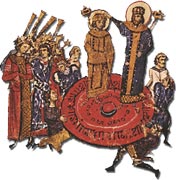The Palace and the Royal Life
Next
>
Official processions in the life of the royal family have been described
in the book "History of institutions". In the very
one book could be seen that the Emperor took part in a much broader
part of rituals than in those canonized into Church ritual. Also, many
of them existed long before they became part of an Eclestical life.
Rituals of the Palace survived till the end of Empire.
Emperor's Rooms
In Great Palace,
surrounded by high walls, existed representative buildings and halls
for banquets (Χαλκες, Magnatura, "Tribunal of 19 beds"), like
halls at Δάφνη palace. Some other buildings, erected outside the walls,
like Ioustinian's Ηρηζώτρικλήνη, have never been considered as an Emperor's
private rooms.
 We can see the process of Crowning the new Emperor by the old custom that included the army, where soldiers of the Royal Guard (Praetorians) took an Emperor on a large ("crowning") shield. After that, the Patriarch would put the Crown on an Emperor's head and bless him. The Procession then follows all the way to the Main Street and ends at the Hippodrome. We can see the process of Crowning the new Emperor by the old custom that included the army, where soldiers of the Royal Guard (Praetorians) took an Emperor on a large ("crowning") shield. After that, the Patriarch would put the Crown on an Emperor's head and bless him. The Procession then follows all the way to the Main Street and ends at the Hippodrome. |